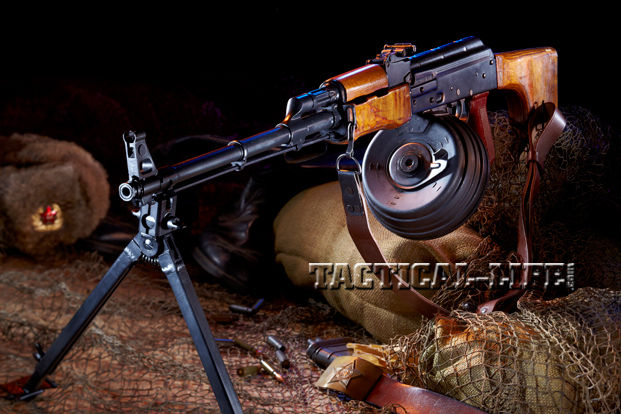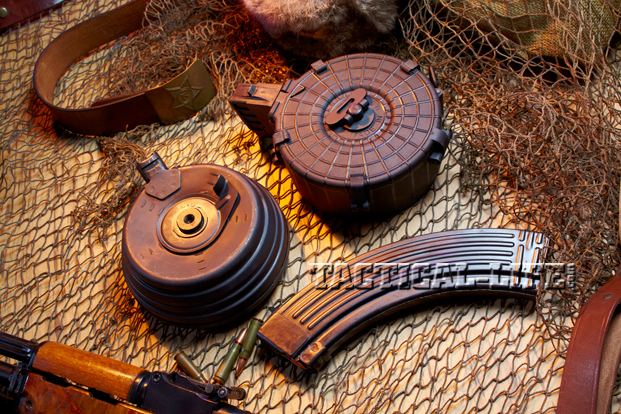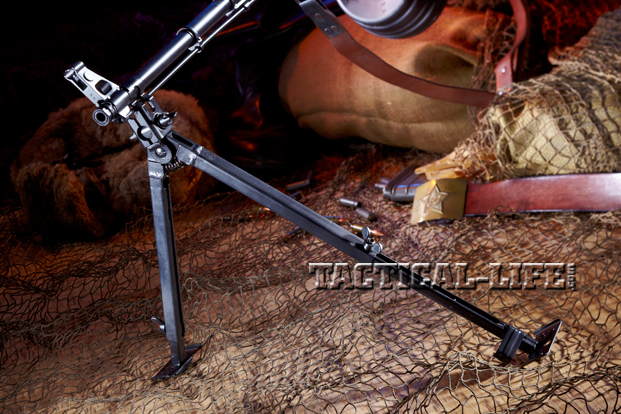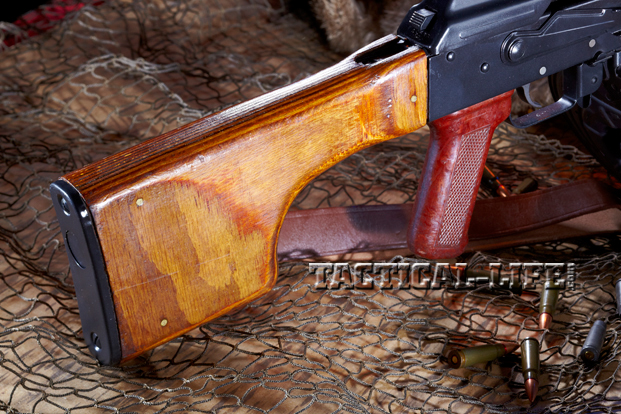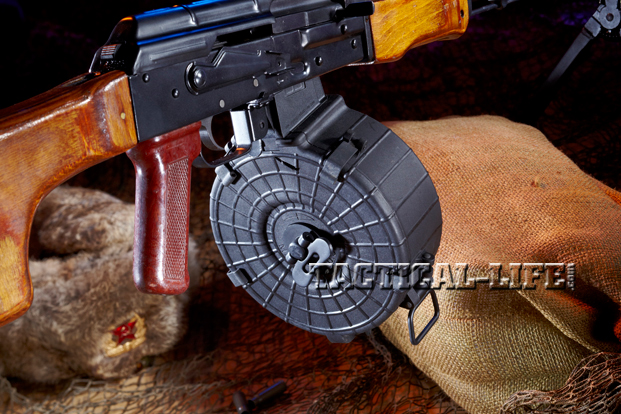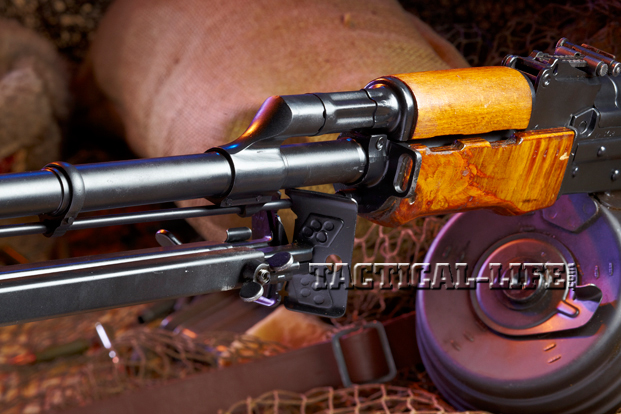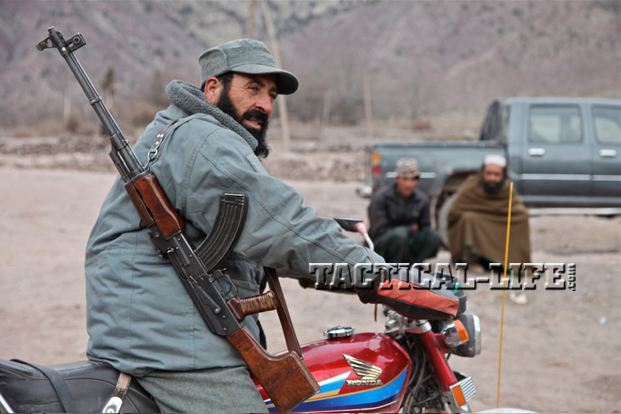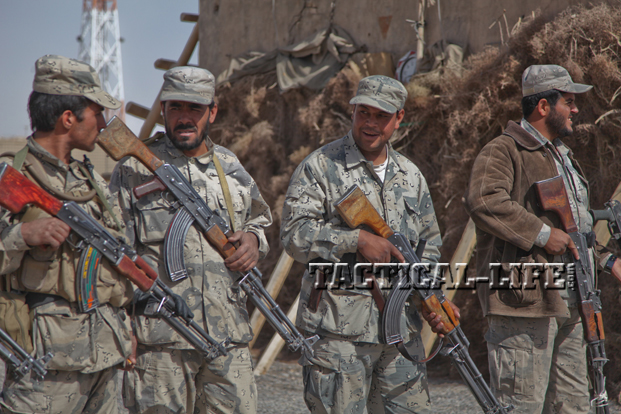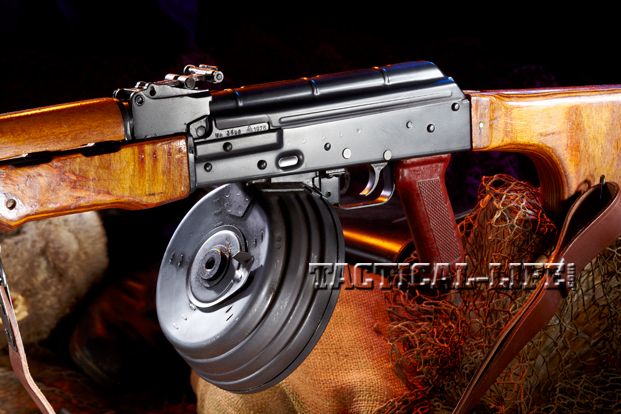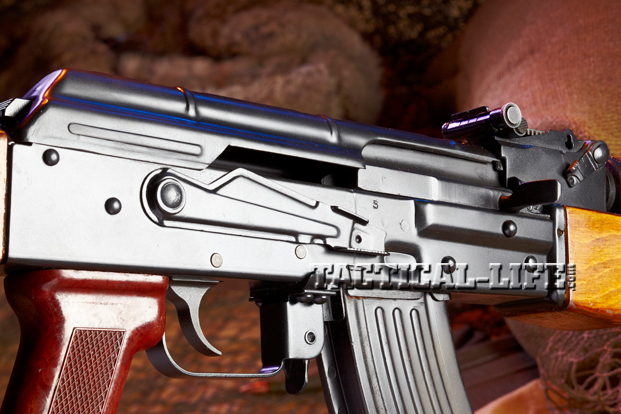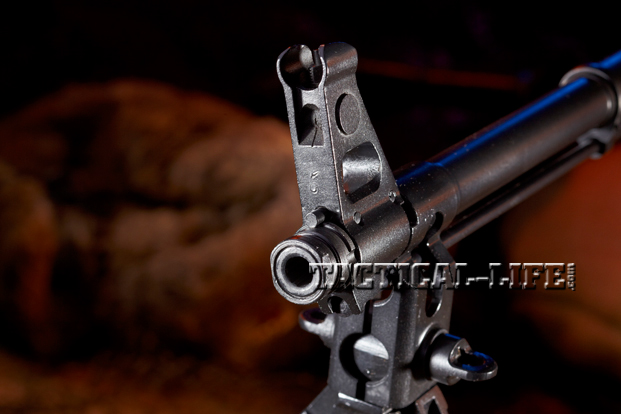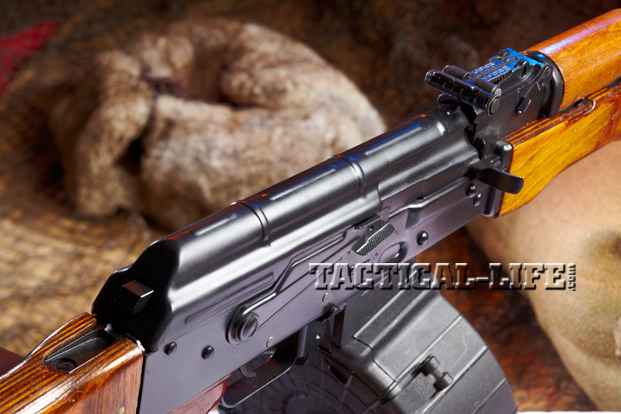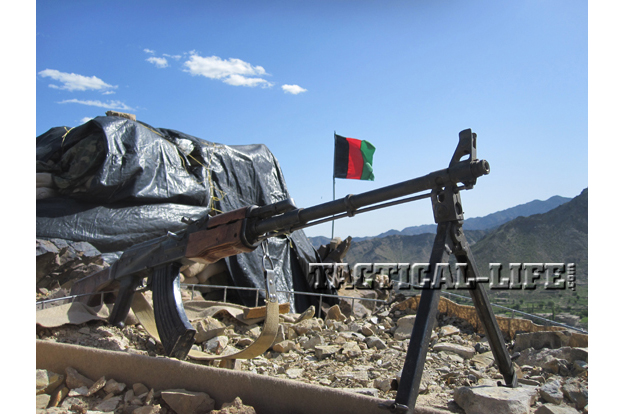To say that the Avtomat Kalashnikova became a paradigm of Soviet-era small-arms design would be a gross understatement. From its beginnings in the late 1940s to its adaptation to the AKM, AK-74, AK-100 series and today’s most current variants, the AK (apart from the brief-aside of the curious AN-94) has been the backbone of everything Soviet, during the Cold War era and beyond. This reality likely stems from the nature of Soviet-era thinking on weapon design as well as the inherent strengths of the basic platform. In general, the Soviets preferred to adapt and refine established systems rather than totally “redesign the wheel.” There was a clear desire, driven in no small part by logistics, to standardize Soviet small arms and have them share as many parts as possible.
While the AK dominated as the Red Army’s infantry rifle after World War II, the Ruchnoi Pulemet Degtyareva (RPD) filled the role of the squad automatic weapon (SAW). Replacing the earlier 7.62x54R DPM (which fed from a top-mounted, pan-style magazine), the RPD ultimately chambered the M43 7.62x39mm intermediate cartridge. The open-bolt RPD was quite popular, no doubt due to the greater rate of fire from its belt-fed operation. But despite the RPD’s success, the Soviet defense industry began considering a replacement system for it. This was likely driven by a desire to minimize costs and simplify logistics and training. It was determined that a new squad automatic based on the AK design would be developed. What resulted was the Ruchnoi Pulemet Kalashnikova (RPK)- Romanian RPK, a 7.62x39mm weapon operationally similar to the AK but modified for the SAW role.
The RPK was, at its core, an evolutionary modification of the Avtomat Kalashnikova Modernizirovanniy (AKM), the modernized AK design that had appeared around the same time period. Surprisingly for a weapon intended as a SAW, the RPK retained the closed-bolt system of firing, the fixed non-removable barrel and the magazine feeding system of the AKM. Although this undoubtedly simplified production and logistics, it did create concerns about the rate of sustained fire and overheating among end users. On the other hand, the RPK had the advantage of being able to share basic parts with the AKM and swap magazines.
Advertisement — Continue Reading Below
So how exactly does the RPK differ from the AKM? First and foremost the RPK features a barrel with a thicker diameter and longer, 23-inch length (versus the more common 16-inch barrel of the AKM). To facilitate prone firing, the barrel is fitted with a muzzle-mounted folding bipod. The RPK’s buttstock is modified with a clubfoot shape at its heel, to facilitate using the support hand to cup the buttstock into the shoulder and adjusting the weapon’s point of impact when firing. Also, the RPK’s oversized forend is much larger than the standard AKM’s, likely to help offset the effects of barrel heat from prolonged firing.
Although it employs a stamped sheet-steel receiver like the AKM, the RPK’s receiver is thickened and reinforced around the forward portion, around an enlarged trunnion. Additionally, the rear sight is upgraded to feature windage adjustments. While the RPK accepts standard AK-pattern magazines, it is primarily fed by either increased-capacity 40-round magazines or 75-round drums.
Romanian Adaptation
As a fan of the design, I had been considering acquiring a semi-auto RPK through a custom build from a parts kit. Accordingly, I kept an eye out for a good quality kit, and while perusing Apex Guns Parts’ website I located a Romanian Model 1964 RPK kit complete with a U.S.-made barrel. Now that I had a line on a parts kit, I realized that to move forward I needed a custom AK builder with the knowledge, skill and equipment required to properly assemble this into a civilian-legal, semi-automatic rifle. After a little digging and some research on theakforum.net, I contacted Troy Sellars of In Range, Inc. for the build. He explained to me that he does not stock AK parts (aside from rivets and some assorted U.S.-made parts) but builds guns with customer-provided parts to his customer’s desired requirements. He also does not currently stock any complete rifles. Sellars explained that the newly manufactured weapon would need to conform to Sec. 922(r) parts compliance requirements (visit atf.gov for more information), meaning it must contain a certain number of domestic versus foreign parts. Sellars explained, “To put it in layman’s terms, a good rule of thumb with Kalashnikovs is that you will need six U.S.-manufactured replacement parts from the BATFE-mandated list for a stamped-receiver rifle like this RPK kit you are considering, and five parts for a comparable milled-receiver rifle.” He suggested that I check out NoDak Spud (NDS) for a semi-automatic receiver for the build. A little research revealed that NoDak Spud makes one of the preeminent U.S.-made, stamped sheet-steel receivers for AK-pattern weapons. (It also offers a host of other products such as retro AR receivers.) All of the NDS receivers are made at a professional ISO 9000–certified stamping house and are fully heat-treated 4130 steel. NoDak receives the units after they’ve been formed and prior to their final heat-treatment, as certain models have additional features cut at NoDak’s facility. After heat treatment, the receivers, which are in the white, are dipped in a rust preventative. At current count, the company offers 19 variations of AK receivers. I selected NoDak’s NDS-7 Romanian RPK receiver, which would match up nicely with the kit. (The NDS-7 features mag dimples to match the early-era Romanian RPKs.)
So, I put in an order for the Apex Gun Parts kit (with a U.S.-made barrel included with the kit) to go to Sellars’ shop, as well as one of the NDS-7 NoDak receivers. As a result, I now had two of the six required U.S.-made parts lined up—I needed four more. Per Sellar’s suggestion, I checked with TAPCO and ordered one of its IntraFuse G2 single-hook trigger groups (made up of a trigger, hammer and disconnector, all of which count as 922(r) parts) and one of its stainless steel AK gas pistons, which were sent to Sellars’ shop. With these six U.S.-made parts, Sellars would be able to use the original complete stock set and muzzle device and keep the RPK’s exterior quite true to the original.
During this discussion with Sellars, I learned that although the Kalashnikov design may be simple, it is not simple to build correctly. It requires experience and skill as well as mission-specific tools and equipment. For example, to install the barrel trunnion, Sellars employs a pneumatic aviation rivet squeezer that provides the right amount of pressure on the rivets from both sides to ensure that they are flared properly. Furthermore, according to Sellars one of the most important aspects of properly building an AK concerns pressing the barrel into the trunnion. He employs a custom pneumatic barrel base that allows him to press the barrel in from the shoulder at its rear rather than from the muzzle.
He went on to explain to me that once the major parts are assembled, he gives the gun a thorough cleaning followed by an aluminum oxide blast and phosphating for rust resistance. For the final finish, the parts were given a coating of a custom mix of KG Teflon Moly that was baked at 300 degrees for an hour. Prior to being shipped to the customer, the rifle goes through a final test-firing and oiling. He advised me that with his backlog of orders I would be looking at a three-month wait on the build at least. After the wait, once it arrived I beheld a rifle that can only be described as beautiful. The KG coating on the gun was flawless, and the original laminated buttstock and forend and the reddish-brown pistol grip were in excellent condition. The threaded muzzle was topped off with the original muzzle nut from the kit. Close inspection of the rifle revealed a convincing RPK clone, with the receiver even featuring a false middle “full-auto” setting for visual authenticity. I did note that the bolt carrier seemed to drag a little when I cycled the action, but not egregiously so. As a side note, when I had ordered the kit from Apex, I also ordered a Romanian 75-round drum (top-feed style) to go with some 40-round Romanian magazines I already had on hand. When I examined the folding bipod I realized that I had lucked up and gotten a kit with adjustable legs. Collapsed, the legs measured roughly 8.25 inches and could extend out an additional 7 inches. To release the bipod, you simply unclip a stamped-steel retaining clip mounted on the left leg from the right leg, squeeze the legs together and rotate them downward.
Advertisement — Continue Reading Below
Shots Downrange
I took the rifle home, broke it down for a more thorough inspection, lubricated it, packed it up with a selection of American Eagle and Remington 7.62x39mm ammunition, and headed out to the range. I set up on the bench and began running the rifle through its paces. The rifle weighed in at around 11 pounds empty, so recoil with the 7.62x39mm was almost nonexistent. With a target set up at 100 yards and firing with the open iron sights, I began running the rifle for accuracy. The trigger pull was a light 4.25 pounds, without a very clear break. Results were good, with the Remington averaging around 3 inches (with a tightest group of around 2 inches) and the American Eagle averaging just under 4 inches (with a tightest group of around 3 inches). I was surprised to find that the longer 23-inch barrel only gained on average about 150 feet per second over a 16-inch-barreled AK I was testing with the same loads.
As far as functioning went, my concerns
about the slight binding of the action proved to be unfounded. The rifle ran through several hundred rounds without a single hiccup. When firing off-hand (a chore considering the weight and length of the rifle), I found the 1.7-inch-wide forend to be very hand-filling and comfortable. It also seemed to do a reasonably good job of minimizing perceived barrel hear during rapid fire.
Takeaway
All in all, I would say that I came away from the project with a great addition for any AK collector’s stable of guns. With a great kit, quality U.S.-made parts and the work of a knowledgeable builder, I ended up with a terrific semi-automatic rendition of a Romanian RPK. In fact, I am so happy with the results that I will be keeping an eye out for any new interesting or rare kits that might appear on that market for my next build project. Maybe you should as well! ★
